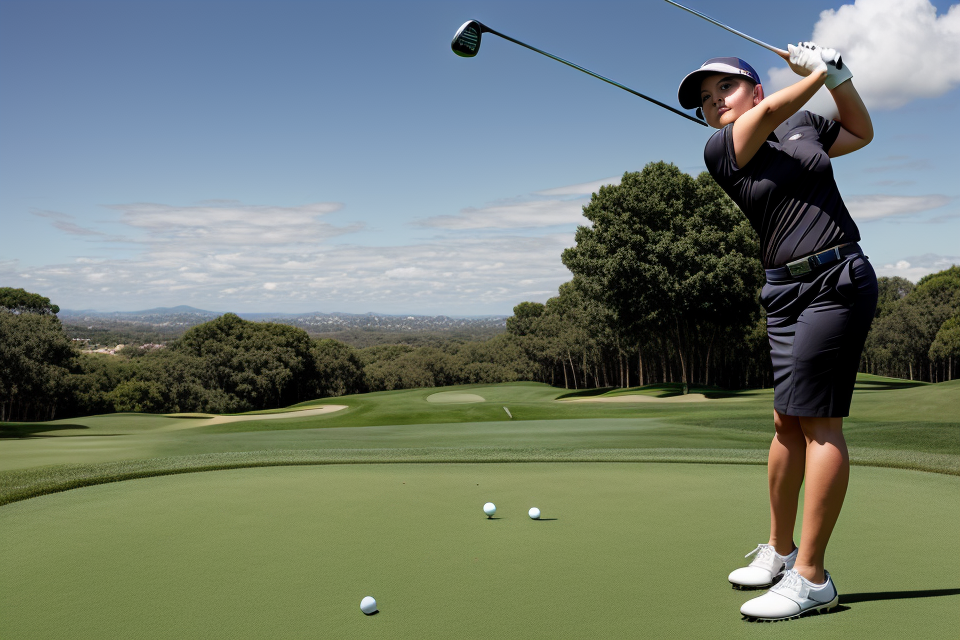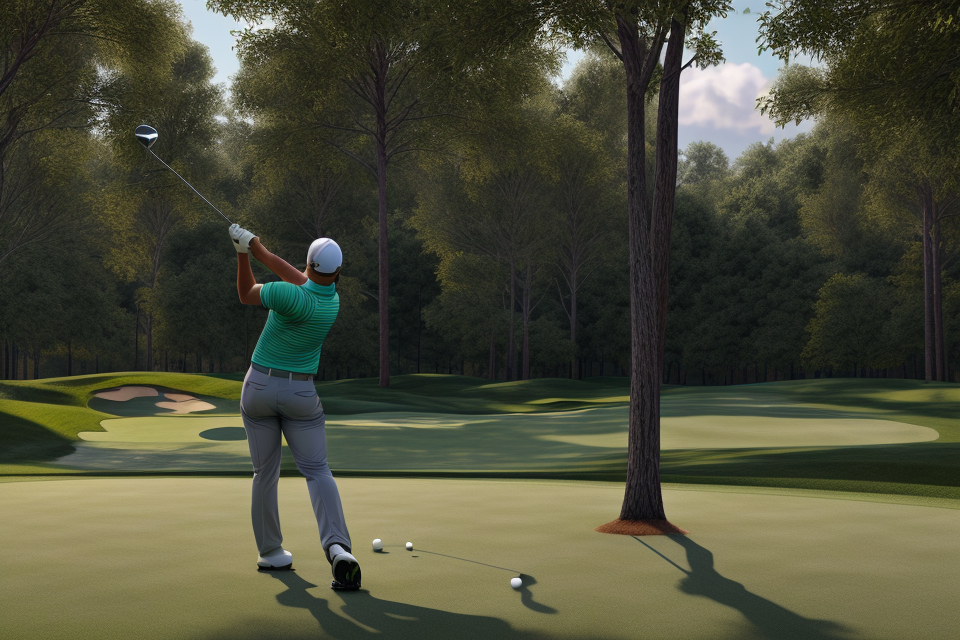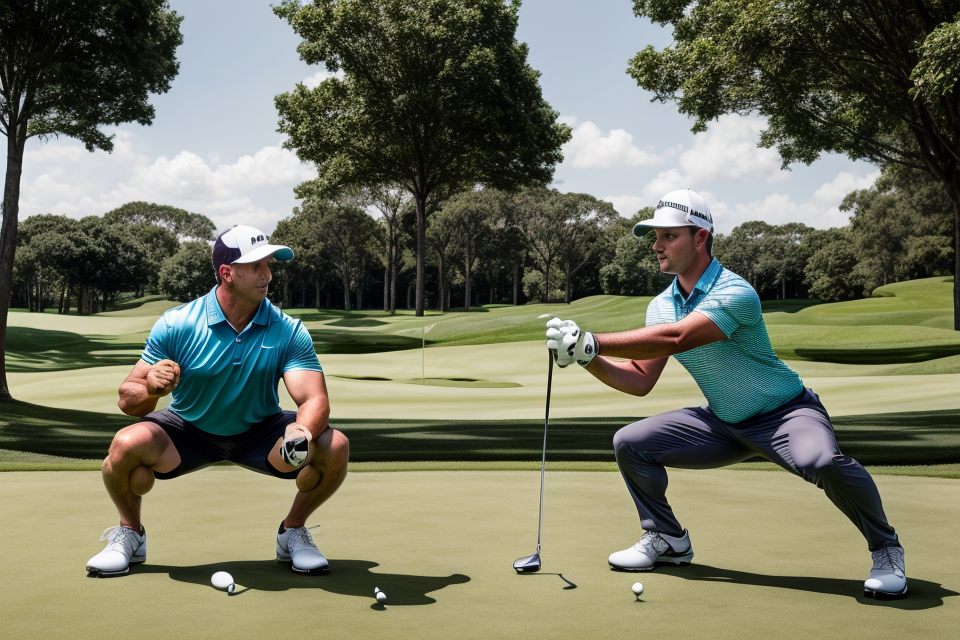
Golf is a sport that requires patience, precision, and practice. If you’re new to the game, learning how to play golf can seem like a daunting task. However, with the right approach and training program, anyone can develop the skills necessary to become a proficient golfer. In this article, we’ll explore some tips and techniques for developing a successful golf training program, including the importance of proper equipment, warming up, and practicing specific shots. Whether you’re a beginner or an experienced golfer looking to improve your game, read on to discover how to develop a winning golf training program.
Setting Goals for Your Golf Training
Identifying Your Strengths and Weaknesses
Identifying your strengths and weaknesses is a crucial step in developing a successful golf training program. This step involves a self-assessment of your current golf skills and seeking feedback from a golf instructor or coach. Here are some details on how to do this:
- Conduct a self-assessment of your current golf skills: This involves analyzing your current abilities and identifying areas where you excel and areas that need improvement. To do this, you can keep a record of your scores over a period of time, and compare them to identify trends. You can also video record your swings and analyze them for consistency and form.
- Seek feedback from a golf instructor or coach: A golf instructor or coach can provide an objective assessment of your skills and identify areas that need improvement. They can also provide guidance on how to improve your swing, technique, and overall game. It is important to choose an instructor or coach who is experienced and has a good reputation.
By identifying your strengths and weaknesses, you can develop a targeted training program that focuses on improving your weaknesses while building on your strengths. This will help you become a more well-rounded golfer and improve your overall game.
Setting Realistic Goals
When setting goals for your golf training program, it’s important to make sure they are realistic and achievable. Here are some tips for setting realistic goals:
- Break down your long-term goals into smaller, achievable steps: Long-term goals can be overwhelming, so break them down into smaller, more manageable steps. This will help you stay motivated and focused on your progress.
- Set short-term goals that build on each other to reach your long-term objectives: Short-term goals should be specific and achievable within a certain time frame, such as a week or a month. These goals should build on each other and help you progress towards your long-term objectives.
- Be realistic about your current skill level: It’s important to be honest with yourself about your current skill level and what you need to work on. Setting unrealistic goals can be demotivating and set you up for failure.
- Consider your available time and resources: Be realistic about the amount of time and resources you have available to dedicate to your golf training program. Setting goals that are too demanding can lead to burnout and discouragement.
- Be flexible and willing to adjust your goals: As you progress through your golf training program, you may find that your goals need to be adjusted. Be flexible and willing to make changes as needed to ensure that your goals remain realistic and achievable.
Creating a Golf Training Schedule
Allocating Time for Practice
- Determine how much time you can commit to practicing each week
- Schedule regular practice sessions to build consistency and muscle memory
It is essential to determine how much time you can commit to practicing each week. This will help you create a realistic golf training schedule that fits your lifestyle and allows you to achieve your goals. If you have a busy schedule, you may need to allocate more time to practice during the weekends or evenings. However, it is crucial to ensure that you are not sacrificing other important aspects of your life, such as family time or work, to make time for golf practice.
Once you have determined how much time you can commit to practicing each week, you should schedule regular practice sessions to build consistency and muscle memory. Consistency is key when it comes to improving your golf skills, and regular practice sessions will help you develop the necessary muscle memory to perform at your best on the golf course. You should aim to schedule practice sessions at least three to four times a week, with each session lasting at least an hour.
When scheduling your practice sessions, it is important to consider the different aspects of golf that you need to work on. For example, if you want to improve your swing, you may want to allocate more time to practicing your swing in the driving range. On the other hand, if you want to improve your putting, you may want to allocate more time to practicing on the putting green. By scheduling your practice sessions based on your specific goals, you can ensure that you are making the most of your practice time and making progress towards your goals.
Choosing the Right Practice Drills
Selecting the right practice drills is crucial for improving your golf skills. Here are some tips to help you choose the most effective drills:
- Identify your weaknesses: Start by assessing your current golf skills and identifying the areas where you need improvement. Focus on drills that target those specific areas.
- Match your skill level: Choose drills that are appropriate for your skill level. If the drills are too easy, you won’t see any improvement, but if they are too difficult, you may become frustrated and demotivated.
- Vary your practice routine: While it’s important to focus on specific areas of improvement, it’s also important to vary your practice routine to avoid boredom and maintain motivation. Incorporate a mix of different drills and techniques to keep your practice sessions interesting and engaging.
Remember, the key to success is to choose practice drills that are challenging, but achievable. With consistent effort and the right drills, you can improve your golf skills and achieve your goals.
Incorporating Physical Conditioning
- Develop a conditioning program that focuses on golf-specific movements and strength training
- Incorporate flexibility and mobility exercises to prevent injuries and improve performance
To develop a successful golf training program, it is essential to incorporate physical conditioning that focuses on golf-specific movements and strength training. This can include exercises such as resistance training, plyometrics, and functional training that target the muscles used in golf swings, such as the legs, core, and upper body.
Additionally, incorporating flexibility and mobility exercises is crucial to prevent injuries and improve performance on the golf course. These exercises can include stretches and movements that target the muscles and joints used in golf swings, such as the hips, shoulders, and wrists.
It is important to note that physical conditioning should be tailored to the individual’s current fitness level and goals. A professional trainer or coach can help design a personalized conditioning program that takes into account any existing injuries or limitations.
Moreover, it is important to allow for proper recovery and rest between workouts to avoid overuse injuries and to allow for muscle growth and repair. This can include active recovery methods such as light exercise or stretching, as well as proper nutrition and hydration to support the body’s recovery processes.
In summary, incorporating physical conditioning that focuses on golf-specific movements and strength training, as well as flexibility and mobility exercises, is crucial for developing a successful golf training program. It is important to tailor the conditioning program to the individual’s needs and goals, and to allow for proper recovery and rest between workouts.
Seeking Professional Guidance
Finding a Qualified Golf Instructor
When it comes to developing a successful golf training program, seeking professional guidance is crucial. One of the most effective ways to do this is by finding a qualified golf instructor who can help you refine your skills and improve your game. Here are some tips on how to find the right instructor for you:
- Research local golf instructors: Start by researching local golf instructors in your area. You can ask for recommendations from other golfers, check online reviews, or look for listings on golf-related websites. Make sure to select an instructor who is accessible and convenient for you.
- Select an instructor with a proven track record of success: Look for instructors who have a proven track record of success with their students. This could include former professional golfers, college coaches, or instructors who have trained successful tour players. Check their credentials and ask for references to ensure they have the experience and expertise to help you improve your game.
- Consider certifications and endorsements: Look for instructors who have certifications and endorsements from reputable organizations such as the PGA or LPGA. These organizations offer rigorous training and testing programs that ensure instructors have the knowledge and skills to teach golf effectively. Additionally, instructors who have endorsements from other golf professionals or have been featured in golf magazines or on TV are likely to have a high level of expertise.
Overall, finding the right golf instructor is essential to developing a successful golf training program. By researching local instructors, selecting one with a proven track record of success, and considering certifications and endorsements, you can find an instructor who can help you improve your game and achieve your golfing goals.
Working with a Golf Coach
- Consider working with a golf coach who can provide personalized feedback and guidance
- Seek out a coach who has experience working with players at your skill level
Working with a golf coach can be a highly effective way to improve your skills and take your game to the next level. Here are some tips to consider when working with a golf coach:
- Look for a coach who has experience working with players at your skill level. It’s important to find a coach who understands the challenges and goals that are specific to your level of play.
- Consider a coach who specializes in the areas where you need the most improvement. For example, if your short game is weak, look for a coach who has a strong reputation for helping players improve their short game.
- Choose a coach who communicates well and is easy to understand. A good coach should be able to explain complex concepts in a way that is easy to understand, even for beginners.
- Look for a coach who is flexible and can adapt to your schedule. Golf coaching sessions can be time-consuming, so it’s important to find a coach who is willing to work with you to find a schedule that works for both of you.
- Finally, choose a coach who is supportive and encouraging. A good coach should be able to help you build confidence and stay motivated as you work towards your goals.
Mental Game
Developing a Positive Mindset
Cultivate a growth mindset and embrace challenges
- Recognize that challenges are opportunities for growth and learning
- Embrace a mindset that views setbacks as temporary and surmountable
- Believe in your ability to improve and develop new skills through hard work and dedication
Learn to manage your emotions and stay focused during competition
- Develop strategies for managing stress and anxiety, such as deep breathing and visualization techniques
- Focus on the present moment and avoid getting caught up in negative thoughts or self-doubt
- Set realistic goals and celebrate small victories along the way to maintain motivation and focus
Visualization Techniques
Visualization is a powerful tool that can help golfers improve their performance on the course. By mentally rehearsing shots and game strategy, golfers can build confidence and reduce anxiety. Here are some tips for using visualization techniques in your golf training program:
- Be specific: When visualizing shots, be as specific as possible. Imagine the type of shot you want to hit, the club you will use, and the trajectory of the ball. This will help you create a clear mental image of the shot and increase the likelihood of success.
- Use all your senses: In addition to visualizing the shot, try to incorporate other senses into your visualization. For example, imagine the sound of the ball hitting the club, the feel of the club in your hands, and the smell of the grass. This will help create a more immersive mental experience.
- Repeat the visualization: Practice your visualization techniques by repeating the mental rehearsal several times. This will help ingrain the mental image into your brain and make it easier to recall during the actual shot.
- Incorporate emotions: Visualize yourself successfully completing the shot and imagine the positive emotions that come with it. This will help build confidence and reduce anxiety on the course.
- Use visualization before and during the shot: Visualization can be used both before and during the shot. Before the shot, use visualization to mentally prepare for the shot. During the shot, use visualization to maintain focus and stay positive.
By incorporating visualization techniques into your golf training program, you can improve your mental game and increase your chances of success on the course.
Goal Setting for the Mental Game
- Set mental goals that align with your physical goals: Your mental goals should complement your physical goals, so it’s important to align them. This will help you focus on what you want to achieve in both your short-term and long-term golfing journey.
- Break down mental goals into smaller, achievable steps: Setting achievable mental goals is key to building confidence and momentum. Break down your goals into smaller, manageable steps that you can work towards. For example, if your goal is to improve your mental toughness, you could start by setting a goal to practice visualization for 10 minutes each day. As you progress, you can increase the time and complexity of your visualization exercises.
- Create a timeline for achieving your mental goals: Give yourself a deadline for achieving your mental goals. This will help you stay motivated and focused on your progress. For example, if your goal is to improve your mental toughness, you could set a deadline of one month to achieve this goal. As you progress, you can adjust your timeline as needed.
- Monitor your progress and adjust your goals as needed: Keep track of your progress towards your mental goals. If you find that you’re not making progress, it may be time to adjust your goals or try a different approach. Be open to making changes to your mental training program as needed to ensure that you’re making progress towards your goals.
FAQs
1. What are the basic steps to learning how to play golf?
The basic steps to learning how to play golf include getting fitted for the right equipment, learning the grip and stance, and practicing the basic swing. It’s important to start with the fundamentals and gradually build up to more advanced techniques. This can include practicing on a driving range, taking lessons from a golf pro, and playing on a regular basis to develop your skills.
2. How important is physical fitness for playing golf?
Physical fitness is important for playing golf, as it can help improve your endurance, strength, and flexibility. This can help you swing the club with more power and accuracy, and reduce the risk of injury. It’s important to incorporate exercises that target the muscles used in golf, such as the legs, core, and upper body.
3. What are some common mistakes to avoid when learning to play golf?
Some common mistakes to avoid when learning to play golf include gripping the club too tightly, swinging too fast, and not using the correct body movements. It’s important to focus on the basics, such as the grip and stance, and to practice swinging slowly and smoothly. Additionally, it’s important to avoid getting frustrated and to stay positive, as this can negatively impact your performance.
4. How can I improve my accuracy when playing golf?
Improving your accuracy when playing golf can be achieved by focusing on your aim, using the correct body movements, and practicing your swing on a regular basis. It’s important to pay attention to your form and to make adjustments as needed. Additionally, using a laser rangefinder or other distance measuring device can help you gauge the distance to the hole and improve your accuracy.
5. What are some tips for improving my driving distance in golf?
Improving your driving distance in golf can be achieved by using the correct body movements, swinging with power, and using the right equipment. It’s important to focus on your form and to use your legs, core, and upper body to generate power. Additionally, using a driver with a larger head and longer shaft can help increase your distance.
6. How can I reduce my score in golf?
Reducing your score in golf can be achieved by practicing your swing and aim, using the correct techniques, and playing on a regular basis. It’s important to focus on your form and to make adjustments as needed. Additionally, using a golf GPS watch or other distance measuring device can help you gauge the distance to the hole and reduce your score.


